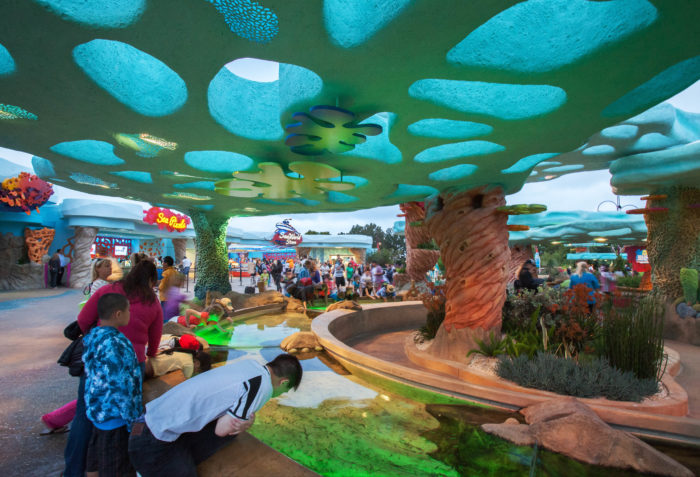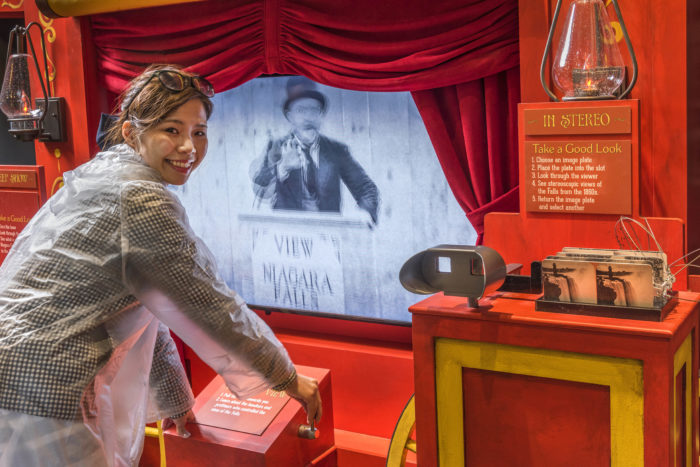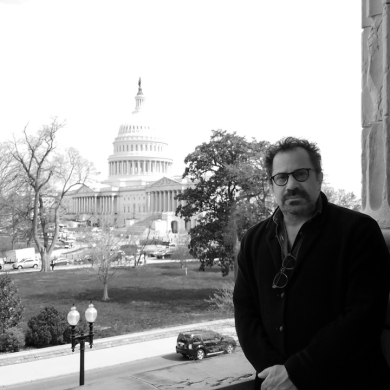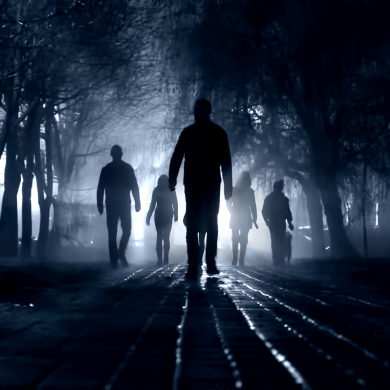Published Date: 02-19-20
By Justin Sanders
Think of the last time you went on a ride, or strolled through a museum exhibition, or visited an aquarium, zoo, or some other location that was built to be interacted with.
You probably remember the way the experience made you feel – thrilled perhaps, or intrigued, or delighted, or bored. But do you remember why you felt the way you did? Were you conscious of the details of the space, the way its rails or hallways or placards or displays moved and guided you from beginning to end? The way colors and shapes and materials converged into a certain mood?
Were you aware that a story was unfolding all around you?
Most likely, you were not. You were there to have fun, or to learn, or to see something new and interesting. You weren’t concerned with how the place worked its spell on you – you were just there to be enchanted. You understandably left those nitty-gritty details to people whose job it is to worry about such things. People like Carol Breeze, Senior Experience Designer for PGAV Destinations.
Based in St. Louis, Breeze has helped create interactive experiences at destinations ranging from SeaWorld to Niagara Falls. She has helped bring zoo visitors into the fascinating world of great apes and taken guests on a mission through the Kennedy Space Center Visitor Complex. Her job is to design “stories that people can walk through,” she told CreativeFuture. Sometimes those stories are overt. Other times, Breeze said, the experience “turns out to be a setting for people to make their own stories in.” But she always sets out with one question in mind: “What can make this attraction a transformational experience?”
CreativeFuture caught up with Breeze at PGAV’s offices near the Gateway Arch (yet another attraction she has worked on) to hear how she and her team of architects, writers, videographers, illustrators, and other creatives go about finding the answer.
JUSTIN SANDERS: How would you describe your job to a layperson?
CAROL BREEZE: My job is to help develop a vision for a story that guests can be immersed in. So, I think about all the things that the guests to a given attraction can do. What moments can they share together? What can make coming to this attraction a transformational experience?
JS: Wow! Transformational?
CB: [Laughs] I know that sounds really lofty, but we feel like if you’re going to invest the time and money to go do something with your friends or your family, it should be transformational. It should be something that sticks with you – that maybe even changes you in some way.
JS: What is an example of a recent attraction you worked on that provides a transformational experience?
CB: Explorer’s Reef at SeaWorld San Diego. It’s the entry point to the park. Before PGAV came in, SeaWorld had the original front gate from when the park first opened, and it was basically just a really simple ticketing structure. You would come in and it might take a while before you saw an actual animal. It didn’t feel like you were entering an oceanic experience, and the client wanted to deliver on the SeaWorld story promise that you’re entering the sea.
So, we set out to put animals right beyond the turnstiles, putting in four tidepools so you can touch water as soon as you walk through the gate. We picked a Coral Reef as our setting. It was a major design challenge.
JS: Why? It sounds so simple.
CB: Explorer’s Reef was intended to set the tone for your whole day at SeaWorld. It wasn’t just about putting in some tidepools with a cool setting. We had to think about how you have to get out of your car in the parking lot – which isn’t fun – and then you have to walk to the ticketing area and through the turnstiles, and you have to wait in lines and go through bag check, and none of that’s ever fun, right?
JS: Right.
CB: Those are parts of the theme park experience that you always have to do, and we just accept them. So, we thought about where those pain points of the processing segment could instead become part of that feeling of going to the beach, and then into the sea.
So, as you’re walking in, our design makes you feel that same sense of anticipation that you feel when you’re heading to the beach. You see the swaying palms, you see the sand dunes, you see the tall sea grasses, and then once you go through the turnstiles and under the wave, you come out, and you’re in this reef world now. You get to reach out and touch water and touch a shark or a ray. The moment of realization that you’ve arrived at SeaWorld is putting your hand in a tidepool. You’re here.
JS: It’s definitely not something you think about when entering a theme park – that someone designed the experience all the way up to where you come in from the parking lot.
CB: I love that we brought a beach arrival experience to SeaWorld. I love that we put a touch experience 15 feet from the turnstile. That’s really unusual in parks – usually you have to look around a little bit for that first engagement. I thought that was a really bold and beautiful move on our part.
It was just a fun project to design. When you’re underneath our coral reef canopies, and you’re reaching and touching the water and the animals, it really makes all the other stuff that’s going on in the park go away, and helps you focus on that moment you are having with your friends and family.

JS: When you were a kid, and you visited themes parks and museums and other experiential attractions, did you ever think about designing them yourself one day?
CB: I had no idea this career existed growing up, but after I got this job, as an adult, my grandmother told me, “You know, you used to draw roller coasters when you were a kid – all the time.” So, that was kind of interesting.
My grandparents used to take us kids to the boardwalk in Wild Wood, New Jersey, where there were a lot of amusement park rides. One of the things I always remember is that we would get on a coaster and there was always a spot where my grandfather stood, and we knew that when we got to a certain point along the ride, that we should look toward that spot because he would be there, waving to us. That’s something that I think about now when we’re designing rides and attractions – where’s the place where you wave to grandpa?
Just building in these touchpoints where people can connect makes it more memorable… more special.
JS: When did you realize that designing rides and attractions was a viable career path?
CB: I stumbled onto this career. I have a Bachelor of Fine Arts in painting, and a Master of Fine Arts in interactive media. I started out working as a graphic designer, but it didn’t fulfill me. There was something more that I wanted. I always liked telling stories and I thought interactivity was interesting, but I didn’t really know what to do with it. It was through my master’s program that I found out about PGAV – this place where you could create stories that people can walk through.
It was a logical step for me, but it wasn’t something I set out to do. In the beginning, I was just looking for a job at a place that interested me. I didn’t know how much I would enjoy working with zoos and aquariums and theme parks until I worked with PGAV.
JS: What was your first project with PGAV?
CB: I came in as a graphic designer, and I first worked on an exhibit called Fragile Forest at the Saint Louis Zoo, which is a great ape exhibit. They have orangutans and chimpanzees and gorillas there, and this project was for their outside enclosure. A lot of these animals had come from really difficult backgrounds. Some of them had never seen the outside world, and the Zoo was creating this place for them where they could be in a habitat that, for the first time, fit their natural lifestyle.
My job on that project was to create stories about the individual animals. I created storybooks and worked with the Zoo to understand the background of each of the chimpanzees – what had brought them to the Zoo, how they came together to form a community, and so on. It was pretty amazing to hear their experiences and share their story.
JS: How does a new project begin?
CB: We start off by sitting down with the client and just listening to them. We listen until we feel like we understand fundamentally what the project needs, and then we start to brainstorm. In the beginning, it’s really messy, but this is my favorite part of the project. I love the design challenge of having all these different pieces the client has provided, and they don’t quite fit, and then you have to figure out with your team how to bring them together into a compelling vision.
JS: What are the tools of your trade? How do you go about documenting that compelling vision and communicating it to others?
CB: There are a lot of tools we use. Some people even draw with pencil still, which is awesome!
When I’m designing, my thinking tool is Adobe Illustrator and my sketchbook. I also use Photoshop, and I have to use PowerPoint a lot – [laughs] which often offends my design sensibilities but is a really good collaborative tool.
A lot of our work involves designing elements meant to be actualized out in the real world, which requires a variety of tools to take our clients and the broader design team through the physical spaces we are imagining. We use AutoCAD and RevIt for project documentation and coordination; we use a variety of 3D visualization tools like Unreal, Vray and Lumion; and we use SketchUp, Z Brush, 3DStudio Max, and Rhino to create 3D models.
JS: Do you go in person to the sites where your designs will live?
CB: At different phases of the project, different people visit the site for different reasons. During the concept and early design phases, we’re going there to understand the place that we’re creating an attraction for, or to talk to the client. Then, later, we’re going to measure and verify things, and to just make sure that what we’re designing reconciles with the reality of the site. We would want to make sure, for instance, that there isn’t some giant electrical conduit where we want to, say, put a tidepool.
From there, a general contractor gets involved, and they just start building. There are all kinds of steps involving art direction, interfacing with the contractor and other fabricators on site. Once we start construction, everything moves really fast and we have to make quick decisions to make sure everything is going as smoothly as possible.
JS: When I expressed interest in this interview to PGAV’s communications team, I was sent a booklet that lays out the company’s storytelling ethos in great detail – including, to my surprise, a lengthy passage on Joseph Campbell’s notion of the Hero’s Journey. How important is it to have a narrative through-line when designing these attractions?
CB: There always has to be some sort of emotional driver at the core of the experience. Sometimes that driver turns out to be a setting for people to make their own stories in – like at Explorer’s Reef. Other times, we are creating a clear narrative that guests are following. At the Kennedy Space Center Visitors Complex, for instance, we take guests through the story of how the Space Shuttle was more than a rocket – it was a dream brought to life by dedicated people.
I think when you’re going to any kind of attraction, it should touch you at multiple levels.
JS: Can you provide an example of an attraction you helped design where multiple levels of narrative and emotion are at play?
CB: Cave of the Winds at Niagara Falls. It’s an attraction where guests put on ponchos, take an elevator down to the base of the gorge, and then walk out on ramps and walkways to stand really close to Bridal Veil Falls. It’s exciting and fun, but it is also very low-capacity. Only so many people can go down in the elevator and fit on to the ramps, so there are always a lot of long lines. The client asked us to help create an experience before Cave of the Winds to give people something to do while waiting to go down – but also to make the experience even more meaningful, to give it more depth.
The story nugget that we started with was the idea of power. When you touch the falls, it’s really powerful, but there’s also this whole history to that power, and it’s pretty interesting. The 1893 World’s Fair was powered by energy from Niagara Falls. It was a collaboration between the Westinghouse electric company and Nikola Tesla. So, there’s a story of literal energy, of harnessing the power of the falls at the turn of the century, that is amazing and cool.

At the same time, Niagara Falls wasn’t yet a state park. Chunks of it were owned by different people, and you would have to pay someone a buck just to look at the falls off in the distance, through a peep hole – which seems crazy now. So, this “Free Niagara” movement started up, claiming the falls were a natural wonder, and that industry was destroying natural spaces and people needed them to be preserved. And though Niagara Falls is a state park, the Free Niagara movement was the model for what would become the National Park System.
Both ideas, at the time, were foreign. The idea of harnessing a waterfall for energy, and the idea of protecting a waterfall for people to look at just didn’t make sense to most people. That tension between the desire to harness the energy of the falls, and the desire to protect them, became the heart of our story. We wove a narrative that takes you through the history of the falls through the lens of power, and then it ends with your journey to touch the falls, to actually feel that power with your own hands.
JS: What is the most challenging part of the work you do, and what is the most rewarding part?
CB: The most challenging thing is also the most rewarding. I love having a professional reason to visit these super-fun locations and experiences, but I also always joke that my job might require me to go around to three theme parks in one day – [laughs] by myself. Even super-fun things can feel like work when they are part of your job.
Another challenge is that you need time to develop really cool concepts – but everybody wants to build everything faster. You can’t squeeze construction time, but you can try to squeeze design time, and finding a way to really delve into a project and make it unique is both the fun part and the hard part.
JS: What advice would you have for someone who wants to do what you do – to be an experience designer?
CB: There are many different skills involved with communicating our vision for a museum or a theme park or other attraction. Having expertise in one of those skills is key – whether it’s architecture, writing, graphic design, videography, industrial design, interior design, art, illustration, or visualization. We’re all storytellers, but we each bring a different skill and a unique perspective that is needed to create experiences and places that are truly compelling and memorable for guests.
So, that’s my advice: Find the thing that you love to do, and if that skill can help tell a story, give us a call!



